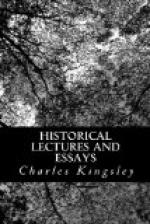and envy could suggest, the man who dared not only
to revolutionise surgery, but to interfere with the
privileged mysteries of medicine; and, over and above,
to become a greater favourite at the court of the
greatest of monarchs. While such as Eustachius,
himself an able discoverer, could join in the cry,
it is no wonder if a lower soul, like that of Sylvius,
led it open-mouthed. He was a mean, covetous,
bad man, as George Bachanan well knew; and, according
to his nature, he wrote a furious book—“Ad
Vesani calumnias depulsandas.” The punning
change of Vesalius into Vesanus (madman) was but a
fair and gentle stroke for a polemic, in days in which
those who could not kill their enemies with steel
or powder, held themselves justified in doing so,
if possible, by vituperation, calumny, and every engine
of moral torture. But a far more terrible weapon,
and one which made Vesalius rage, and it may be for
once in his life tremble, was the charge of impiety
and heresy. The Inquisition was a very ugly place.
It was very easy to get into it, especially for a
Netherlander: but not so easy to get out.
Indeed Vesalius must have trembled, when he saw his
master, Charles V., himself take fright, and actually
call on the theologians of Salamanca to decide whether
it was lawful to dissect a human body. The monks,
to their honour, used their common sense, and answered
Yes. The deed was so plainly useful that it must
be lawful likewise. But Vesalius did not feel
that he had triumphed. He dreaded, possibly,
lest the storm should only have blown over for a time.
He fell, possibly, into hasty disgust at the folly
of mankind, and despair of arousing them to use their
common sense, and acknowledge their true interest
and their true benefactors. At all events, he
threw into the fire—so it is said—all
his unpublished manuscripts, the records of long years
of observation, and renounced science thenceforth.
We hear of him after this at Brussels, and at Basle
likewise—in which latter city, in the company
of physicians, naturalists, and Grecians, he must
have breathed awhile a freer air. But he seems
to have returned thence to his old master Charles
V., and to have finally settled at Madrid as a court
surgeon to Philip II., who sent him, but too late,
to extract the lance splinters from the eye of the
dying Henry II.
He was now married to a lady of rank from Brussels,
Anne van Hamme by name; and their daughter married
in time Philip II.’s grand falconer, who was
doubtless a personage of no small social rank.
Vesalius was well off in worldly things; somewhat
fond, it is said, of good living and of luxury; inclined,
it may be, to say, “Let us eat and drink, for
to-morrow we die,” and to sink more and more
into the mere worldling, unless some shock should
awake him from his lethargy.
And the awakening shock did come. After eight
years of court life, he resolved, early in the year
1564, to go on a pilgrimage to Jerusalem.




